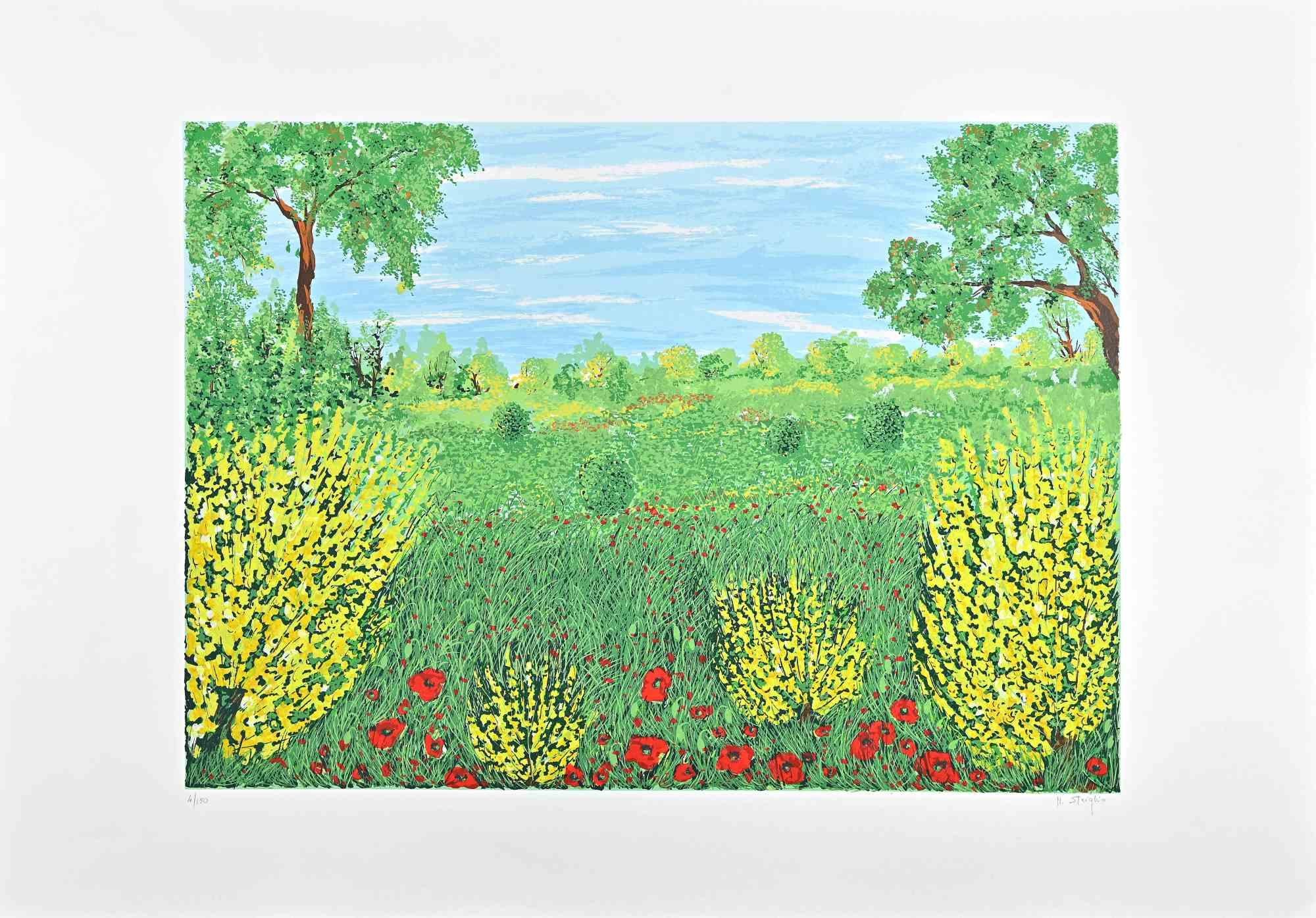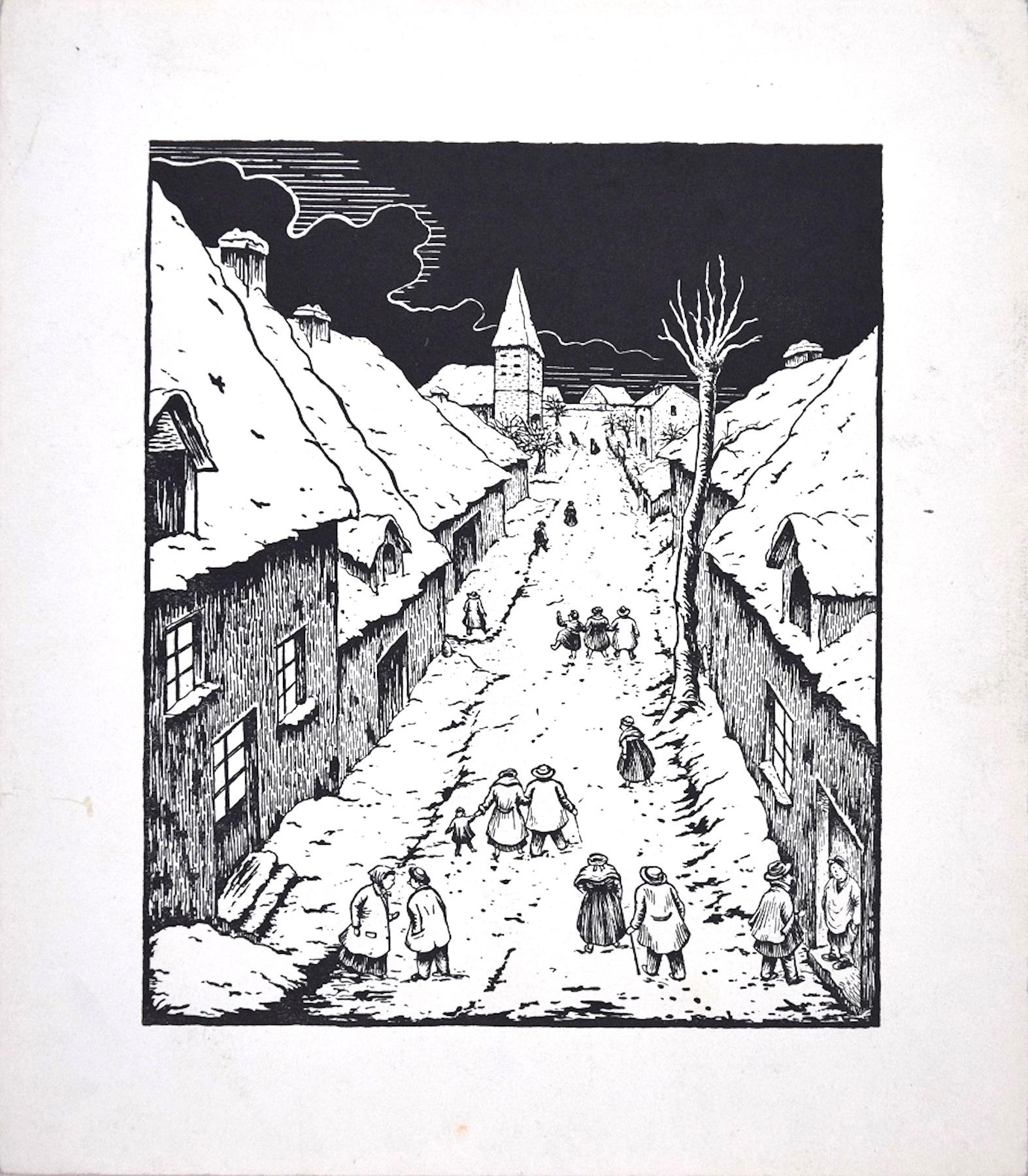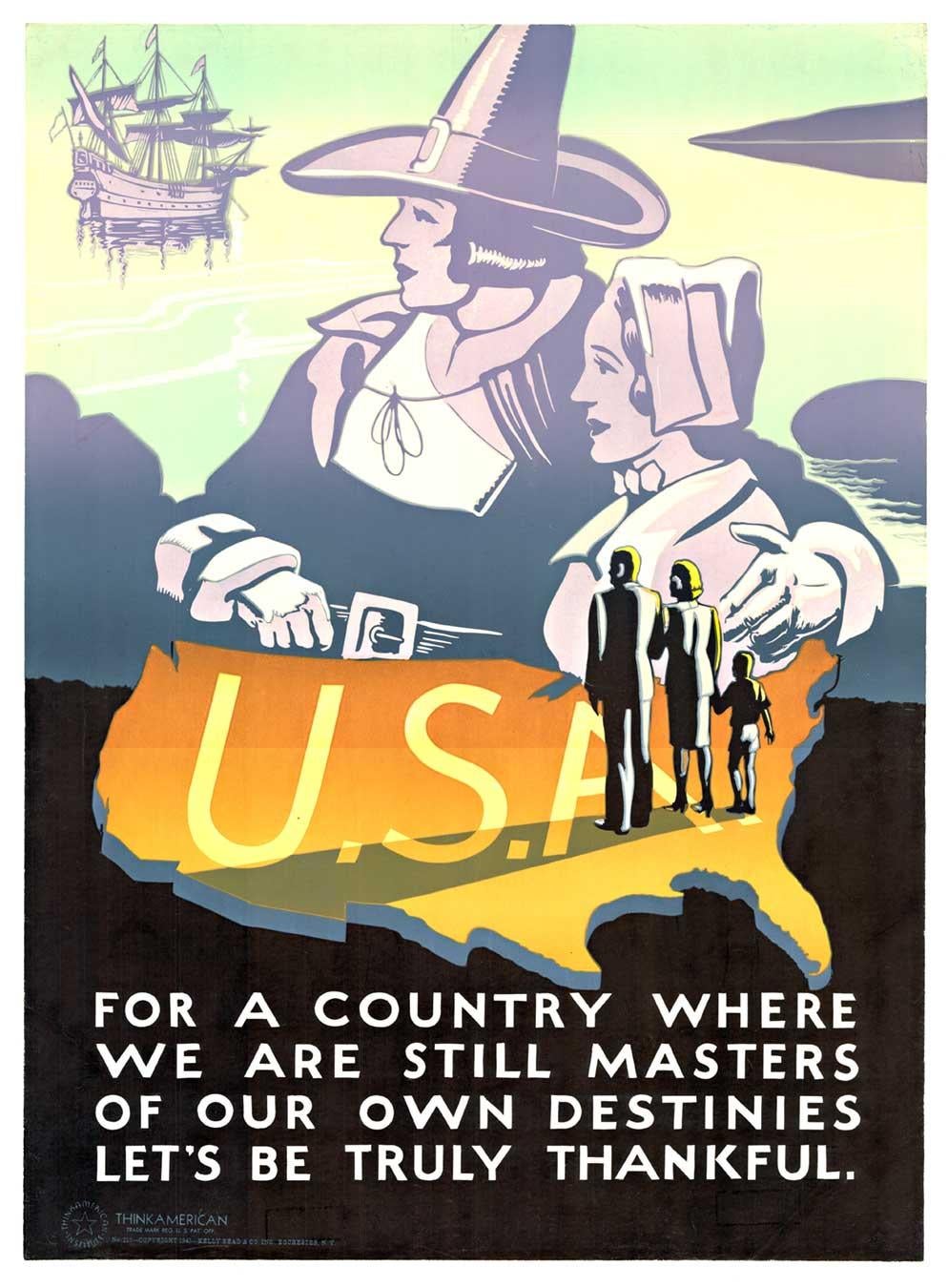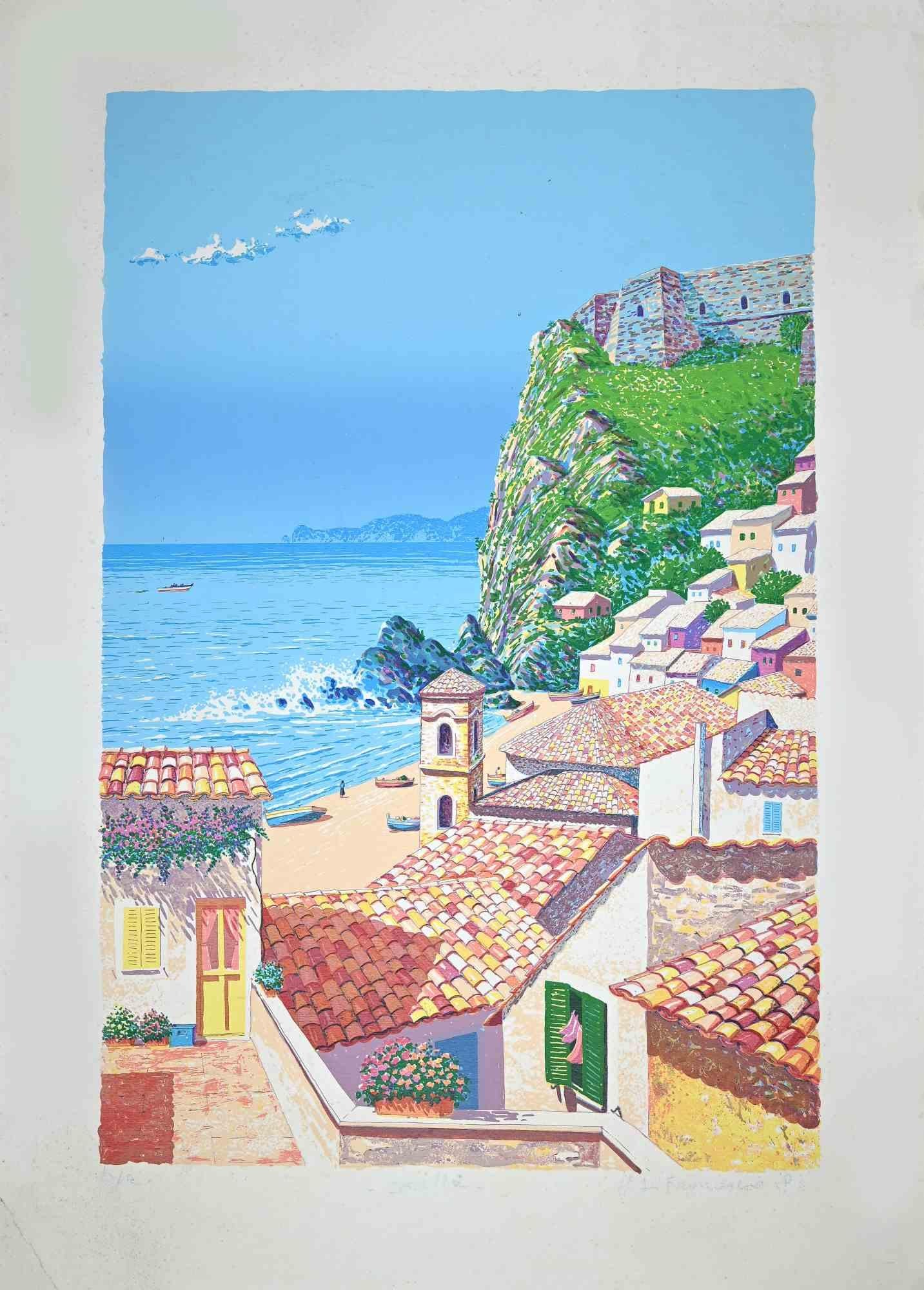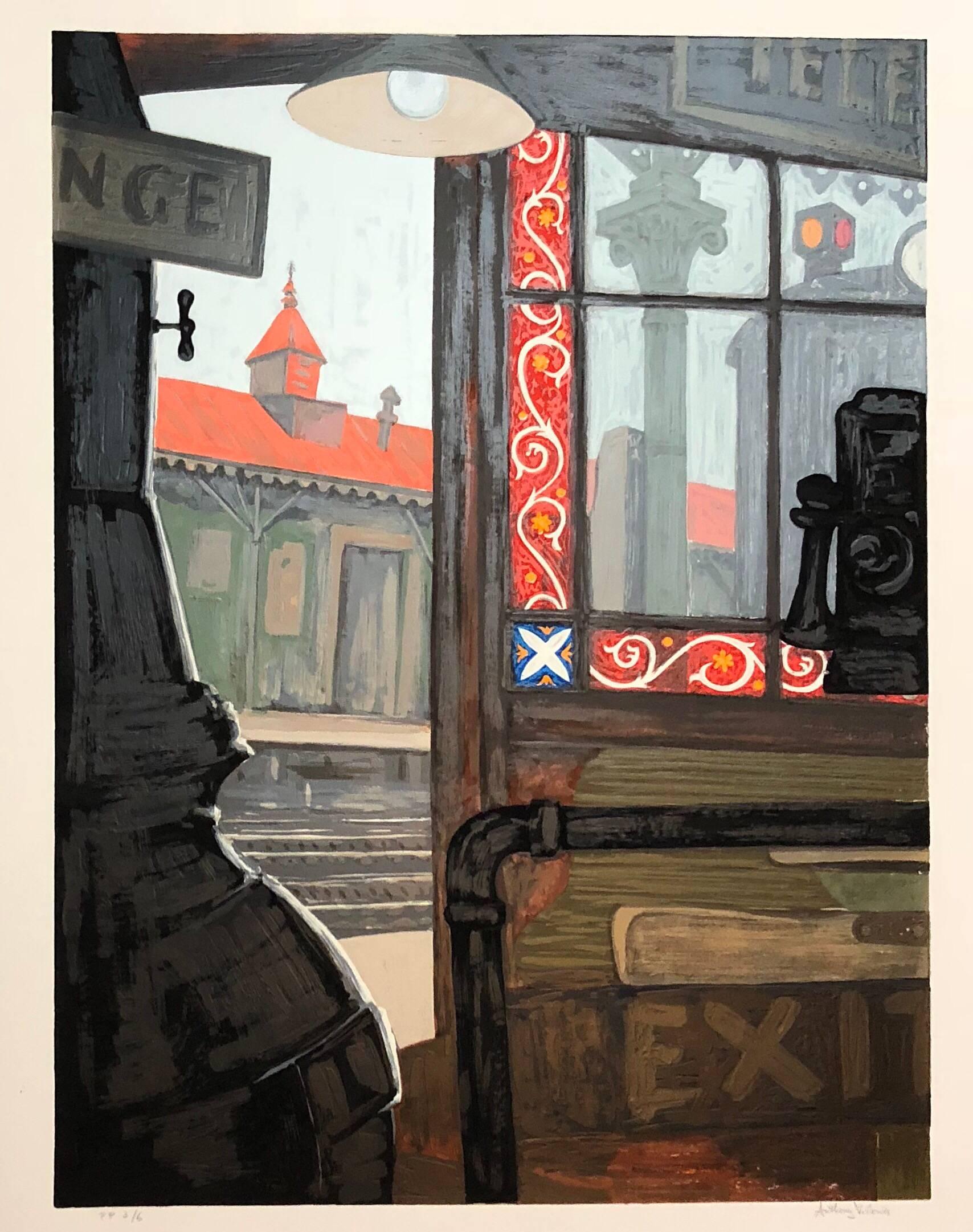Items Similar to PULLING CORN (FODDER HOPPER) - Scarce Print!
Want more images or videos?
Request additional images or videos from the seller
1 of 9
Bernard Joseph SteffenPULLING CORN (FODDER HOPPER) - Scarce Print!c. 1940
c. 1940
About the Item
BERNARD (JOSEPH) STEFFEN (1907 – 1980)
PULLING CORN (FODDER HOPPER) c. 1935-45
Color serigraph signed with a full signature below the image at the lower right sheet edge . Unknown edition, but very scarce. 11 x 13 7/8 inches, sheet 16 x 20 ½ inches. Some slight tone within the mat opening and some slight discoloration at the edges of the large margins. Tape at upper sheet edge verso, small loss upper right corner edge.
A RARE LARGER SCALE Steffen serigraph with all the strength of his mannered compositional style.
Born in Kansas, Steffen was associated with the Regionalist Movement. He was a painter and produced lithographs and serigraphs. He created many prints under the WPA. Steffen is often associated with Thomas Hart Benton. Although 20 years younger Steffen was roommates with Benton in 1928 while they were both at Colorado Springs. They had a close relationship thereafter as a friend and mentor. His works are in many museums. His WPA / Federal Art Project prints are held in 13 Museum collections according to the GSA catalog on the WPA. Steffen’s most common prints were published by Associated American Artists in New York.
Regionalism, WPA, Midwest, Workers
- Creator:Bernard Joseph Steffen (1907 - 1980, American)
- Creation Year:c. 1940
- Dimensions:Height: 11 in (27.94 cm)Width: 13.75 in (34.93 cm)
- Medium:
- Movement & Style:
- Period:
- Condition:
- Gallery Location:Santa Monica, CA
- Reference Number:1stDibs: LU411312520402
About the Seller
5.0
Recognized Seller
These prestigious sellers are industry leaders and represent the highest echelon for item quality and design.
Platinum Seller
These expertly vetted sellers are 1stDibs' most experienced sellers and are rated highest by our customers.
Established in 1977
1stDibs seller since 2016
267 sales on 1stDibs
Typical response time: <1 hour
Associations
International Fine Print Dealers Association
- ShippingRetrieving quote...Ships From: Santa Monica, CA
- Return PolicyA return for this item may be initiated within 7 days of delivery.
More From This SellerView All
- THE MAKING OF TORTILLAS - Mural Size 47 1/2 inches LongBy Leopoldo MéndezLocated in Santa Monica, CALEOPOLDO MENDEZ (1902 – 1969) THE MAKING OF TORTILLAS 1954 Linocut. Edition unknown. This example signed in pencil and dated 1957. 14” x 47 3/8” ...Category
1950s Modern Figurative Prints
MaterialsLinocut
- JonahBy Sadao WatanabeLocated in Santa Monica, CASADAO WATANABE (Japanese 1913-1996) JONAH, 1959 Color stencil, signed, numbered and dated in white ink. Sheet, 25 5/8 x 22 5/8 inches. Edition: 44/50. Good color and generally good ...Category
1950s Modern Figurative Prints
MaterialsStencil, Woodcut
- VILLAGE SCENE / TOWN FESTIVALBy Herbert GurschnerLocated in Santa Monica, CAHERBERT GURSCHNER (Austrian / English (1901-1975) VILLAGE SCENE / TOWN FESTIVAL ca.1924 Color woodcut 4 ¾ x 5 3/8” Signed in pencil. Good strong colors. On thin paper. Faint darkeni...Category
1920s Modern Figurative Prints
MaterialsWoodcut, Linocut
- MON DOUX OU-ETES-VOUS? / MY SWEET COUNTRY, WERE ARE YOU?By Georges RouaultLocated in Santa Monica, CAGEORGES ROUAULT (1871-1958) MON DOUX OU-ETES-VOUS? / MY SWEET COUNTRY, WERE ARE YOU? 1927 ( Chapon/Rouault 97; Wofsy 151) Miserere XLIV Aquatint, 1927, on laid Arches. watermark...Category
1920s Modern Landscape Prints
MaterialsAquatint
- FOG, GOG, AND MAGOGBy Roberto MattaLocated in Santa Monica, CAROBERTO MATTA (1911-2002) FOG, GOG, AND MAGOG 1971 Color lithograph. Plate 1 from “Fog Gog, and Magog” 1971. Signed in pencil and numbered. This work is number 92 from the edition o...Category
1970s Surrealist Landscape Prints
MaterialsLithograph
- JOB SACRIFICED - And My Servant Job Shall Pray For YouBy William BlakeLocated in Santa Monica, CAWILLIAM BLAKE (British 1757-1827) JOB'S SACRIFICE - And my Servant Job Shall Pray For You, 1825 (Bindman 1978.643; Binyon 1926.123 iii; Russell 1912.33) Engraving, First edition, one of 100 sets printed directly onto Whatman wove paper with a 1825 watermark. and the word “proof” removed. From "Illustrations of the Book of Job...Category
1820s English School Figurative Prints
MaterialsEngraving
You May Also Like
- Explosive Spring -Original ScreenPrint by Maddalena Striglio - Late 20th centuryLocated in Roma, ITExplosive Spring is a very brightly colored screen print realized by the contemporary Italian artist Maddalena Striglio in the late 20th Century. ...Category
Late 20th Century Modern Landscape Prints
MaterialsScreen
- Nocturnal Village - Original Screen Print by Lucie NavierBy Lucie NavierLocated in Roma, ITNocturnal Village is an original artwork realized by the French artist Lucie Navier (1910-1996) in the 1930s. Original black and white serigraph...Category
1930s Modern Landscape Prints
MaterialsScreen
- Original "Think American" USA World War II vintage posterLocated in Spokane, WAOriginal poster: For a Country Where We Are Still Masters of Our Own Destinies, Let's Be Truly Thankful. Silk-screened patriotism. This is a poster meant to appeal to the American family. Soft, rich colors and a patriotic vision... This poster has been archivally mounted on linen and is in fine condition condition. Touched up pin-holes in the corners. A- condition. The Original Think American, USA World War 2 Poster is a captivating piece of history and art. This vintage poster showcases a unique design that captures the era's essence. It features a pilgrim couple gazing out to sea towards their three-master schooner, representing America's pioneering and adventurous spirit. The outline of the United States is a powerful symbol of national pride and strength. The large text along the bottom of the poster delivers a thought-provoking message, reminding viewers to be grateful for the country where they can shape their own destinies. Created and printed by Think America, a renowned brand, this poster is a true collector's item that celebrates American history and values. The ghosted image of early Pilgrims seems to reach out to the American family who are standing on an outline of the United States. The old sailing...Category
1940s American Modern Figurative Prints
MaterialsScreen
- Sea View - Screen Print - 1990sLocated in Roma, ITSea View is an original Screen Print, realized by an anonymous artist in the 1990s. The status of preservation Good. The artwork is depicted skillfully thro...Category
1990s Modern Figurative Prints
MaterialsScreen
- Meadow with Poppies - Screen Print by Maddalena Striglio - Late 20th centuryLocated in Roma, ITMeadow with Poppies is a very brightly colored screen print realized by the contemporary Italian artist Maddalena Striglio in the late 20th Century. Hand-signed in pencil on the lo...Category
Late 20th Century Modern Landscape Prints
MaterialsScreen
- Modernist Silkscreen Screenprint 'El Station, Interior' NYC Subway, WPA ArtistBy Anthony VelonisLocated in Surfside, FLscreenprint printed in color ink on wove paper. New York City subway station interior. Anthony Velonis (1911 – 1997) was an American painter and designer born in New York City who helped introduce the public to silkscreen printing in the early 20th century. While employed under the federal Works Progress Administration, WPA during the Great Depression, Velonis brought the use of silkscreen printing as a fine art form, referred to as the "serigraph," into the mainstream. By his own request, he was not publicly credited for coining the term. He experimented and mastered techniques to print on a wide variety of materials, such as glass, plastics, and metal, thereby expanding the field. In the mid to late 20th century, the silkscreen technique became popular among other artists such as Robert Rauschenberg and Andy Warhol. Velonis was born into a relatively poor background of a Greek immigrant family and grew up in the tenements of New York City. Early on, he took creative inspiration from figures in his life such as his grandfather, an immigrant from the mountains in Greece, who was "an ecclesiastical painter, on Byzantine style." Velonis attended James Monroe High School in The Bronx, where he took on minor artistic roles such as the illustration of his high school yearbook. He eventually received a scholarship to the NYU College of Fine Arts, into which he was both surprised and ecstatic to have been admitted. Around this time he took to painting, watercolor, and sculpture, as well as various other art forms, hoping to find a niche that fit. He attended NYU until 1929, when the Great Depression started in the United States after the stock market crash. Around the year 1932, Velonis became interested in silk screen, together with fellow artist Fritz Brosius, and decided to investigate the practice. Working in his brother's sign shop, Velonis was able to master the silkscreen process. He reminisced in an interview three decades later that doing so was "plenty of fun," and that a lot of technology can be discovered through hard work, more so if it is worked on "little by little." Velonis was hired by Mayor LaGuardia in 1934 to promote the work of New York's city government via posters publicizing city projects. One such project required him to go on a commercial fishing trip to locations including New Bedford and Nantucket for a fortnight, where he primarily took photographs and notes, and made sketches. Afterward, for a period of roughly six months, he was occupied with creating paintings from these records. During this trip, Velonis developed true respect and affinity for the fishermen with whom he traveled, "the relatively uneducated person," in his words. Following this, Velonis began work with the Public Works of Art Project (PWAP), an offshoot of the Civil Works Administration (CWA), where he was assigned to serve the different city departments of New York. After the formation of the federal Works Progress Administration, which hired artists and sponsored projects in the arts, he also worked in theater. Velonis began working for the federal WPA in 1935. He kept this position until 1936 or 1938, at which point he began working in the graphic art division of the Federal Art Project, which he ultimately led. Under various elements of the WPA program, many young artists, writers and actors gained employment that helped them survive during the Depression, as well as contributing works that created an artistic legacy for the country. When interviewed in December 1994 by the Library of Congress about his time in the WPA, Velonis reflected that he had greatly enjoyed that period, saying that he liked the "excitement" and "meeting all the other artists with different points of view." He also said in a later interview that "the contact and the dialogue with all those artists and the work that took place was just invaluable." Among the young artists he hired was Edmond Casarella, who later developed an innovative technique using layered cardboard for woodcuts. Velonis introduced silkscreen printing to the Poster Division of the WPA. As he recalled in a 1965 interview: "I suggested that the Poster division would be a lot more productive and useful if they had an auxiliary screen printing project that worked along with them. And apparently this was very favorably received..." As a member of the Federal Art Project, a subdivision of the WPA, Velonis later approached the Public Use of Arts Committee (PUAC) for help in "propagandizing for art in the parks, in the subways, et cetera." Since the Federal Art Project could not be "self-promoting," an outside organization was required to advertise their art more extensively. During his employment with the Federal Art Project, Velonis created nine silkscreen posters for the federal government. Around 1937-1939 Velonis wrote a pamphlet titled "Technical Problems of the Artist: Technique of the Silkscreen Process," which was distributed to art centers run by the WPA around the country. It was considered very influential in encouraging artists to try this relatively inexpensive technique and stimulated printmaking across the country. In 1939, Velonis founded the Creative Printmakers Group, along with three others, including Hyman Warsager. They printed both their own works and those of other artists in their facility. This was considered the most important silkscreen shop of the period. The next year, Velonis founded the National Serigraph Society. It started out with relatively small commercial projects, such as "rather fancy" Christmas cards that were sold to many of the upscale Fifth Avenue shops...Category
1980s American Modern Figurative Prints
MaterialsScreen
Recently Viewed
View AllMore Ways To Browse
Vintage Puller
Pull Vintage
Vintage Corning
Corn Sign
Vintage Spring Scale
Benton Lithograph
Lithograph Hopper
Steffen Thomas
Consignment Vintage
Japanese Rainbow Flower
Retro Style Kettle
Vintage Laundry Print
Vintage Sunflower Field
Albion Press
Benton Etching
Chinese Tiffany Studio
Picasso White Clown In Frame
Prairie Printmaker
